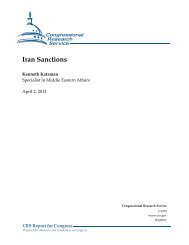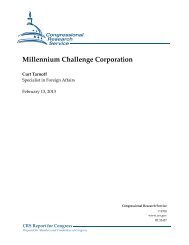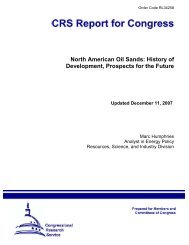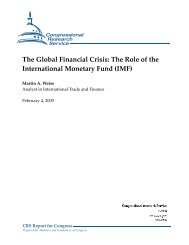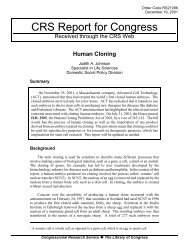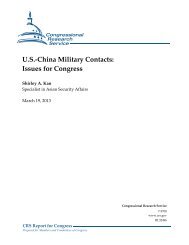Bahrain: Reform, Security, and U.S. Policy - Foreign Press Centers
Bahrain: Reform, Security, and U.S. Policy - Foreign Press Centers
Bahrain: Reform, Security, and U.S. Policy - Foreign Press Centers
You also want an ePaper? Increase the reach of your titles
YUMPU automatically turns print PDFs into web optimized ePapers that Google loves.
<strong>Bahrain</strong>: <strong>Reform</strong>, <strong>Security</strong>, <strong>and</strong> U.S. <strong>Policy</strong><br />
Table 1. Comparative Composition of National Assembly<br />
2006 2010<br />
Council of Representatives (COR)<br />
Post-By-Election<br />
(October 2011)<br />
Wifaq (Shiite Islamist) 17 18 0<br />
Shiite Independent 0 0 8<br />
Sunni Independent (mostly<br />
secular) in COR<br />
Moderate Sunni Islamist<br />
(Minbar, Muslim<br />
8 17 27<br />
Brotherhood)<br />
Conservative Sunni<br />
7 2 2<br />
Islamist (Asala, Salafi) 8 3 3<br />
COR Sect Composition 23 Sunni, 17 Shiite 22 Sunni, 18 Shiite 32 Sunni, 8 Shiite<br />
Women in COR 1 1 4<br />
Shura Council (Upper House, appointed)<br />
Sectarian, Religious<br />
Composition Upper<br />
House (Shura Council)<br />
20 Shiite, 19 Sunni, 1<br />
Christian<br />
19 Shiite, 19 Sunni, 1<br />
Christian, 1 Jew Same as before<br />
Number of Women 9 4 same<br />
2011 Uprising: Origin, Developments, <strong>and</strong> Prognosis<br />
King Hamad’s 10-year effort to satisfy Shiite aspirations were demonstrated to have failed when a<br />
major uprising began on February 14, 2011, in the wake of the success of the uprising in Egypt<br />
against President Hosni Mubarak. After a few days of protests <strong>and</strong> relatively minor confrontations<br />
with the mostly <strong>Bahrain</strong>i Sunni <strong>and</strong> expatriate Sunni security forces, the mostly Shiite<br />
demonstrators converged on the interior of a major traffic circle, “Pearl Roundabout,” named<br />
after a statue that depicted <strong>Bahrain</strong>’s pearl-diving past. The uprising took place after King Hamad<br />
had authorized the latest annual iteration of a $2,700 payment to citizens.<br />
The initial dem<strong>and</strong>s of the protesters centered on altering the constitution to exp<strong>and</strong> the powers of<br />
the COR; ending gerrym<strong>and</strong>ering that prevents Shiites from winning a majority in the COR;<br />
providing more jobs <strong>and</strong> economic opportunities; <strong>and</strong>, among some protesters, replacing hard-line<br />
Prime Minister Khalifa. These moves would, to the mostly Shiite demonstrators, end the sense<br />
that they are “second class citizens” or “not trusted” as <strong>Bahrain</strong>i citizens. On February 15, 2011,<br />
King Hamad spoke to the nation <strong>and</strong> announced the formation of a committee to investigate the<br />
use of force against protestors, which had killed two until that time.<br />
The unrest took on new dimensions in the early morning of February 17, 2011, when security<br />
forces surrounded the thous<strong>and</strong>s of demonstrators in Pearl Roundabout, many of whom were<br />
asleep, <strong>and</strong> used rubber bullets <strong>and</strong> tear gas to remove them from the location. At least four<br />
demonstrators were killed; others died subsequently. The government asserted it had warned of<br />
the impending move, an account disputed by the protesters. At a news conference later on<br />
Congressional Research Service 6



